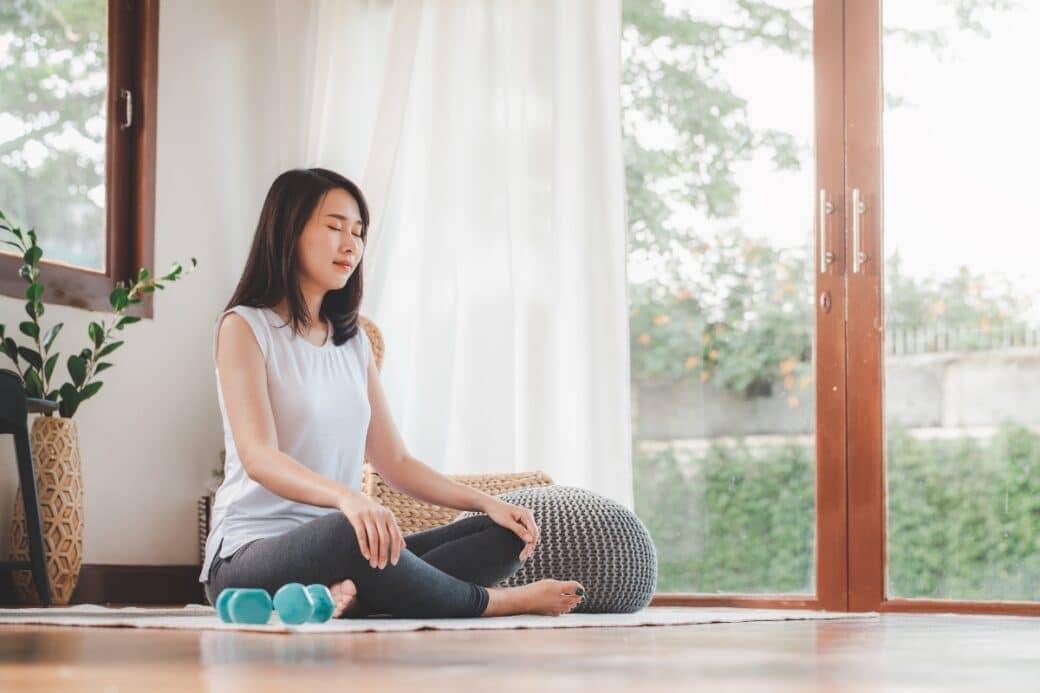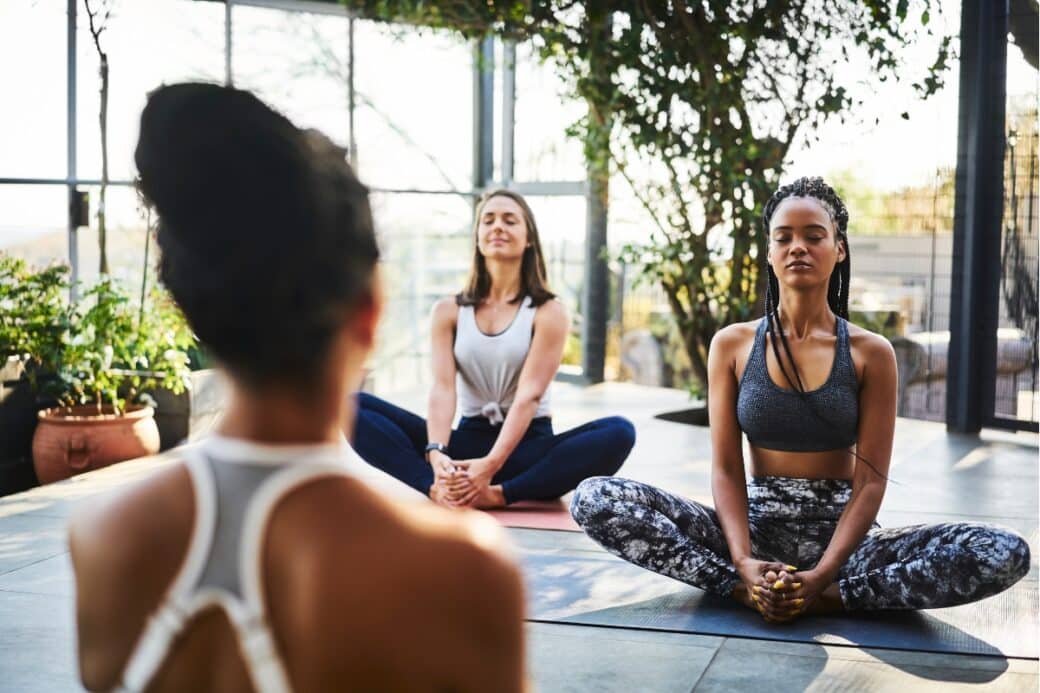Feeling overwhelmed by anxiety? Look no further! This article provides an array of effective meditation exercises specifically designed to help you calm your nerves. Whether you’re a beginner or a seasoned meditator, these practices can be easily incorporated into your daily routine, offering much-needed relief and tranquility. So, take a deep breath, find a comfortable spot, and let’s embark on a journey towards inner peace and relaxation.
Understanding the Link Between Meditation and Anxiety
Anxiety is a common condition that many people experience at some point in their lives. It can cause feelings of worry, fear, and unease, which can interfere with daily functioning and overall well-being. However, research has shown that meditation can be a powerful tool in reducing anxiety levels and promoting a sense of calm and relaxation. By understanding how meditation impacts anxiety and the physical and mental changes that occur during meditation, we can harness its benefits for our own well-being.
Explaining how meditation impacts anxiety
Meditation is a practice that involves focusing your attention and eliminating the stream of thoughts that may be causing stress and anxiety. By redirecting your attention to a specific point of focus, such as your breath or a mantra, you can quiet the mind and create a sense of calm. This practice allows you to observe your thoughts without judgment and develop a greater awareness of your present moment experience.
Physical and mental changes due to meditation
When you engage in meditation, both your body and mind undergo significant changes. Physically, your heart rate and blood pressure decrease, and your breathing slows down. This physiological response helps activate the body’s relaxation response, reducing the symptoms of anxiety. Mentally, meditation helps to quiet the constant chatter of the mind and promotes a sense of clarity and tranquility. It allows you to detach from negative thoughts and emotions, creating space for more positive and peaceful states of mind to arise.
The science behind meditation and anxiety reduction
Numerous scientific studies have investigated the impact of meditation on anxiety levels, and the results consistently show positive outcomes. Researchers have found that regular meditation practice can reduce overall anxiety levels, as well as specific symptoms of anxiety disorders. One study published in the Journal of Alternative and Complementary Medicine showed that individuals who practiced meditation experienced significant reductions in anxiety levels compared to a control group. Another study published in JAMA Internal Medicine found that mindfulness meditation specifically was effective in reducing anxiety symptoms in patients with generalized anxiety disorder.
Benefits of Meditation for Anxiety
Meditation offers a wide range of benefits for managing anxiety. By incorporating a regular meditation practice into your routine, you can experience the following advantages:
Decreased stress levels
One of the primary benefits of meditation for anxiety is its ability to reduce stress levels. When you meditate, your body’s stress response is downregulated, resulting in a decrease in stress hormones such as cortisol. This reduction in stress levels helps to alleviate the physical and psychological symptoms of anxiety, promoting a greater sense of calm and relaxation.
Improved focus and attention
Anxiety often causes the mind to become scattered and overwhelmed by a constant stream of thoughts. Through regular meditation practice, you can enhance your ability to focus and maintain attention. By training your mind to stay present and anchored in the present moment, you develop a greater capacity to direct your attention away from anxious thoughts and towards more constructive and positive mental states.
Enhanced emotional stability
Anxiety can cause intense emotional fluctuations, leading to mood swings and heightened reactivity. Meditation helps to cultivate emotional stability by allowing you to observe your emotions without being carried away by them. By developing a greater awareness of your emotional patterns and triggers, you can respond to challenging situations with greater resilience and equanimity.
Lessened frequency of anxious thoughts
One of the hallmarks of anxiety is the persistent occurrence of anxious thoughts. Regular meditation practice can help to break the cycle of anxious thinking by creating a gap between your thoughts and your identification with them. By observing your thoughts from a place of non-judgmental awareness, you can reduce their intensity and reduce the frequency of anxious thinking.

Importance of Regular Practice
While meditation can offer immediate relief from anxiety, its benefits are most pronounced with regular practice. Consistency is key in reaping the long-term effects that meditation has on anxiety reduction.
Consistency in meditation routine
By establishing a consistent meditation routine, you train your mind and body to enter a state of relaxation and inner calm more readily. Consistency allows you to create a habit and integrate meditation into your daily life, making it easier to access its benefits when anxiety arises.
Long-term impact
Meditation is a practice that yields cumulative benefits. As you continue to meditate regularly, you will notice that the effects of meditation on anxiety become more pronounced over time. Like any skill or habit, meditation requires patience and dedication to fully harness its potential as an anxiety-reducing tool.
Effects of rushed or irregular meditation
While it is important to maintain regularity in your meditation practice, it is equally important to avoid rushing through or skipping sessions. Rushed or irregular meditation can be counterproductive in alleviating anxiety as it prevents you from fully immersing yourself in the practice and reaping its benefits. It is better to allocate a dedicated time for meditation and approach it with a sense of focus and intentionality.
Setting up a Meditation Space
Creating a peaceful environment for meditation can greatly enhance your practice and promote a sense of calm. Consider the following factors when setting up your meditation space:
Choosing a quiet, peaceful location
Select a space in your home or outdoors that is free from distractions and noise. Ideally, this space should be quiet, allowing you to fully immerse yourself in your meditation practice. If silence is not possible, you can use noise-cancelling headphones and soothing music or nature sounds to create a tranquil atmosphere.
Creating a comfortable setting
Ensure that your meditation space is comfortable and inviting. Use cushions, blankets, or a meditation bench to provide adequate support for your body. Comfort is key in ensuring that you can maintain a relaxed posture throughout your meditation practice without experiencing any physical discomfort.
Using objects or elements that promote calmness
Consider incorporating objects or elements that promote a sense of calm and tranquility in your meditation space. This could include candles, essential oils, incense, or plants. Experiment with different elements to find what resonates with you and helps create a soothing atmosphere for your practice.
Meditation Posture: The Key to Effective Meditation
Maintaining a correct posture during meditation is crucial for optimizing the benefits of your practice. By adopting a proper posture, you allow for the free flow of energy and ensure physical comfort. Explore the different postures for meditation and adapt them to your individual comfort and effectiveness.
Importance of maintaining a correct posture
Maintaining a correct posture is essential for deepening your meditation practice. Proper alignment of the spine promotes an optimal flow of energy throughout the body, allowing for a more focused and tranquil state of mind. A correct posture also ensures that you do not experience any physical discomfort or strain during meditation.
Different postures for meditation
There are several postures commonly used in meditation, including the cross-legged sitting position (such as lotus or half-lotus), kneeling position, or sitting on a chair with your feet flat on the ground. Experiment with different postures to find what works best for you in terms of comfort and stability.
Adapting the posture for individual comfort and effectiveness
Remember that the goal of meditation is not to achieve a perfect posture but to find a position that allows you to maintain alertness and relaxation simultaneously. Adjust your chosen posture as needed to ensure that you feel comfortable and supported, allowing your mind to remain focused and present throughout your meditation session.
Breath Focused Meditation
Breath-focused meditation is a simple yet powerful technique that can help alleviate anxiety and promote a calm state of mind. By turning your attention to your breath, you anchor your awareness in the present moment, setting aside anxious thoughts and concerns.
Understanding breath-focused meditation
In breath-focused meditation, the breath serves as the object of focus. By observing the inhalation and exhalation without trying to control or change it, you cultivate a sense of presence and centeredness. The breath becomes a point of anchorage, allowing you to return to the present moment whenever the mind wanders.
Steps to practice breath-focused meditation
- Find a comfortable seated position in your meditation space.
- Close your eyes or soften your gaze, and take a few deep breaths to settle into the present moment.
- Direct your attention to the sensation of your breath at a natural point, such as the nostrils or the rising and falling of the abdomen.
- Observe the breath without judgment, simply noticing the sensations and movements associated with each inhale and exhale.
- Whenever you notice that your mind has wandered, gently bring your attention back to the breath, without berating yourself for the distraction.
- Continue this practice for a predetermined amount of time, gradually increasing the duration as you become more comfortable with the technique.
Benefits of focusing on your breath during meditation
Focusing on the breath during meditation can have profound effects on reducing anxiety. By redirecting your attention to your breath, you interrupt the cycle of anxious thoughts and bring yourself back to the present moment. This refocusing of attention helps to calm the nervous system, activate the relaxation response, and alleviate the symptoms of anxiety.
Body Scan Meditation for Anxiety
Body scan meditation is a practice that involves systematically scanning your body with your attention, starting from the top of your head down to your feet. This technique can help release physical tension and promote relaxation, thereby reducing anxiety levels.
Understanding body scan meditation
Body scan meditation is based on the principle of mindfulness, which involves paying attention to the present moment in a non-judgmental way. By directing your attention to the physical sensations in your body, you cultivate a greater awareness of tension or discomfort and allow it to dissolve, leading to a sense of ease and well-being.
How to practice body scan meditation
- Find a comfortable lying-down position in your meditation space, either on a yoga mat or a soft surface.
- Close your eyes and take a few deep breaths, allowing your body to relax and settle into position.
- Begin by bringing your attention to the sensations in your head and face. Notice any areas of tension or discomfort and consciously release that tension, allowing your head and face to relax.
- Slowly move your attention down to your neck, shoulders, arms, and hands. Scan each area, again releasing any tension you come across.
- Continue scanning your torso, back, hips, legs, and feet, consciously softening and relaxing each area.
- Once you have completed the scan, take a few moments to notice any overall shifts in bodily sensations and the sense of relaxation that may have emerged.
How body scan meditation can help to relieve anxiety
Body scan meditation is an effective tool for relieving anxiety as it helps to release physical tension and promote relaxation. The practice allows you to develop a deeper connection with your body and gain awareness of areas of tension or discomfort that may be contributing to anxiety. By consciously releasing this tension, you create space for relaxation and calmness to emerge, alleviating the symptoms of anxiety.
Loving Kindness Meditation for Anxiety
Loving-kindness meditation is a practice that involves cultivating feelings of compassion, kindness, and goodwill towards oneself and others. This technique can have a profound impact on reducing anxiety by promoting positive emotions and fostering a sense of connection.
Definition of loving-kindness meditation
Loving-kindness meditation involves repeating a series of phrases that express well-wishes and goodwill towards oneself and others. By doing so, you cultivate a sense of benevolence, love, and compassion, which can counteract negative emotions and alleviate anxiety.
Steps to practice loving-kindness meditation
- Find a comfortable seated position in your meditation space.
- Close your eyes or lower your gaze, and take a few deep breaths to settle into a state of relaxation.
- Begin by directing loving-kindness towards yourself. Repeat the following phrases silently or aloud: “May I be happy. May I be safe. May I be healthy. May I live with ease.”
- After a few minutes of focusing on self-compassion, shift your attention towards a loved one, such as a family member or a close friend. Repeat the same phrases, mentally directing them towards this person: “May you be happy. May you be safe. May you be healthy. May you live with ease.”
- Expand your circle of compassion to include acquaintances, colleagues, and even people you may dislike. Repeat the phrases, visualizing each person and genuinely wishing them well-being.
- Finally, extend your loving-kindness to all beings, radiating goodwill and compassion out to the entire world.
How loving-kindness meditation helps with anxiety
Loving-kindness meditation can be a powerful antidote to anxiety by shifting your focus towards positive emotions and fostering a sense of connection. By cultivating feelings of compassion and goodwill, you redirect your attention away from anxious thoughts and replace them with feelings of warmth and acceptance. This practice helps to counteract the negative thought patterns that underlie anxiety, relieving its symptoms and promoting emotional well-being.
Mindfulness Meditation Technique
Mindfulness meditation is a practice that involves intentionally bringing your attention to the present moment with an attitude of non-judgmental awareness. This technique has gained significant popularity in recent years and has been shown to be effective in reducing anxiety.
The basis of mindfulness meditation
The foundation of mindfulness meditation lies in cultivating present moment awareness, observing your thoughts and emotions without judgment. By training your attention to remain focused on the present moment, you develop a greater capacity to respond to anxiety with equanimity and non-reactivity.
How to do mindfulness meditation
- Find a comfortable seated position in your meditation space, ensuring that your spine is straight but not rigid.
- Close your eyes or lower your gaze, and take a few deep breaths to settle into the present moment.
- Begin by bringing your attention to your breath, focusing on the sensations of inhaling and exhaling.
- As thoughts, emotions, or physical sensations arise, simply notice them without judgment or attachment, and gently redirect your attention back to your breath.
- Expand your awareness to include the sensations in your body, the sounds around you, and any other sensory experiences that arise in the present moment.
- Whenever you notice that your mind has wandered, gently bring your attention back to the present moment, allowing each moment to unfold without clinging or resisting.
Role of mindfulness meditation in coping with anxiety
Mindfulness meditation is particularly effective in coping with anxiety as it helps to cultivate a mindset of acceptance and openness towards your thoughts and emotions. By developing non-reactivity and non-attachment to anxious thoughts, you break free from their grip and create space for more constructive and peaceful mental states to emerge. Mindfulness meditation also helps to increase self-awareness, allowing you to recognize early signs of anxiety and respond proactively before it escalates.
Progressive Muscle Relaxation Technique
Progressive muscle relaxation is a technique that involves tensing and then releasing different muscle groups in your body. By systematically engaging and releasing tension, you promote relaxation and alleviate muscle tension associated with anxiety.
Introduction to progressive muscle relaxation
Progressive muscle relaxation is based on the principle that physical relaxation can facilitate mental relaxation. By tensing and releasing different muscle groups, you can learn to recognize the sensations of tension and relaxation and consciously let go of muscle tension when it arises.
Steps to carry out this form of meditation
- Find a comfortable seated or lying-down position in your meditation space.
- Close your eyes and take a few deep breaths to settle into a state of relaxation.
- Begin by focusing on your breathing for a few moments, allowing your body and mind to relax.
- Choose a specific muscle group, such as your hands, and slowly tense the muscles in that area for a few seconds.
- Release the tension in that muscle group and notice the sensations of relaxation and relief.
- Proceed to the next muscle group, such as your arms, and repeat the process of tensing and releasing the muscles.
- Continue this process, systematically working your way through different muscle groups in your body, from your head to your toes.
- As you progress through each muscle group, be mindful of the sensations of tension and relaxation, allowing yourself to fully experience each state.
How this technique can help you calm your nerves
Progressive muscle relaxation is a powerful technique for calming the nervous system and reducing anxiety. By engaging and then releasing tension in your muscles, you interrupt the body’s stress response and activate the relaxation response. This technique helps to alleviate physical symptoms of anxiety, such as muscle tension and restlessness, promoting a sense of calmness and tranquility.
In conclusion, meditation offers a multitude of benefits for managing anxiety. Through regular practice, you can experience decreased stress levels, improved focus and attention, enhanced emotional stability, and a lessened frequency of anxious thoughts. Establishing a meditation routine, creating a peaceful meditation space, practicing proper posture, and exploring different meditation techniques such as breath-focused meditation, body scan meditation, loving-kindness meditation, mindfulness meditation, and progressive muscle relaxation can all contribute to reducing anxiety and promoting a greater sense of calm and well-being. So, carve out some time each day to dedicate to your meditation practice, and you will soon discover the transformative power it holds in calming your nerves and finding inner peace.




